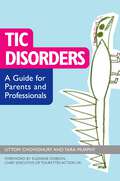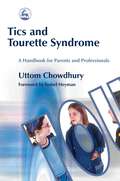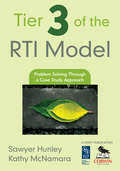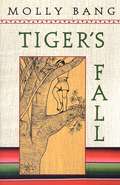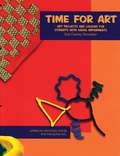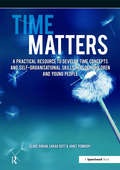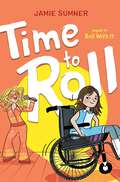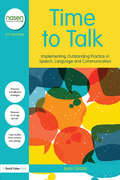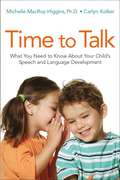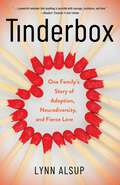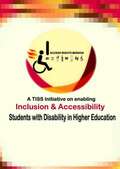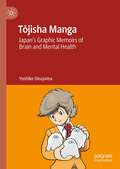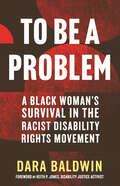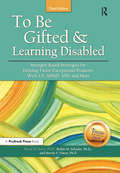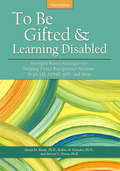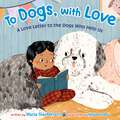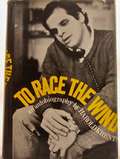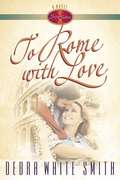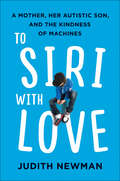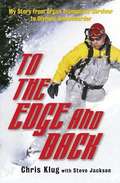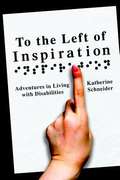- Table View
- List View
Tic Disorders: A Guide for Parents and Professionals
by Suzanne Dobson Uttom Chowdhury Tara MurphyThis is the essential one-stop guide for parents of children and young people with tic disorders and the professionals who work with them. Drawing on current research and their own clinical experience, the authors provide up-to-date information on tic disorders and review the psychological, medical and alternative methods of managing symptoms. Written in clear, accessible language and with practical advice on how to support children with tics at home and in school, the book also includes essential information on the common co-occurring conditions and difficulties, such as ADHD, anxiety, OCD, autism, self-esteem issues and behavioural difficulties.
Tics and Tourette Syndrome: A Handbook for Parents and Professionals
by Uttom ChowdhuryThis essential guide to tic disorders and Tourette Syndrome tackles problems faced both at home and at school, such as adjusting to the diagnosis, the effect on siblings and classroom difficulties. Dr Chowdhury offers advice on how to manage symptoms, describing practical techniques such as habit reversal and massed practice and reviewing available medical treatments. In clear, accessible language, this book explains the clinical signs and symptoms of Tourette and related conditions, and their possible causes. Presenting strategies for dealing with associated difficulties, including low self-esteem, anger-management and bullying, this book will be invaluable to parents, teachers, social workers and other professionals.
Tier 3 of the RTI Model: Problem Solving Through a Case Study Approach
by Kathleen M. McNamara Sawyer HunleyIdentify students’ learning needs and make appropriate decisions regarding instruction and intervention! Written for RTI teams, this resource demonstrates how to conduct intensive, comprehensive evaluations of students who are struggling in the general classroom. Focusing exclusively on the third tier of the RTI model, the book: Provides guidance on problem identification and analysis, progress monitoring, selection of research-based interventions, and evaluation of case study outcomes Addresses both academic and behavioral challenges, including mental health issues Shows how school psychologists can collaborate with other members of the RTI team Provides tools for assessment and for tracking progress
Tiger's Fall
by Molly Bang<P>A feisty little girl learns that physical disability can't limit her ability to make a difference. <P>Lupe loves nothing better than riding her father's horse, El Diablo. Fearless and agile, she rampages around her rural village in Mexico like a tigrilla (little tiger), which is her father's nickname for her. But one day Lupe falls while climbing a tree. Paralyzed from the waist down, she will never again be able to ride El Diablo. Her life might as well be over, she thinks. At first Lupe is filled with rage and self-pity. Her family brings her to a center run by and for disabled people, to recuperate. Despite the evidence around her, she refuses to believe that disabled people can be happy and self-sufficient, and she can't believe that these people think their lives are worth living. But slowly the people and the spirit of the center help Lupe realize that she, too, has something to offer. <P> Award-winning author/illustrator Molly Bang brings emotional honesty and bravery to this compelling, fact-based story of coming to terms with disability.
Tilt: Every Family Spins on Its Own Axis
by Elizabeth BurnsThe story of a mother coming to terms with her daughter's autism and her husbands's manic-depression
Time for Adventure: A Grammar Tales Book to Support Grammar and Language Development in Children (Grammar Tales)
by Jessica HabibJem’s friend, Lottie, has come to play, but Jem is taking all the toys for herself. She learns that adventures are more fun when you share. Targeting Subject-Verb-Object sentences and pronouns, this book provides repeated examples of early developing syntax and morphology which will engage and excite the reader while building pre-literacy skills and make learning fun, as well as exposing children to multiple models of the target grammar form. Perfect for a speech and language therapy session, this book is an ideal starting point for targeting client goals and can also be enjoyed at school or home to reinforce what has been taught in the therapy session.
Time For Art: Art Projects and Lessons for Students with Visual Impairments
by Gail Cawley ShowalterThis simple manual gives some helpful suggestions for people who want to teach art to children who are blind or visually impaired. It also gives some suggestions on projects that the students can do. It is not intended as the "all around authority" on the topic but serves as a spring board into other projects and ideas. Topics and projects include, fake fossils, aluminum repousse, papier mache bowls, wire sculptures, and raised line drawings. Good book for anyone interested in ways to adapt lessons in art for learners with special needs. Also includes art projects which relate to science.
Time Matters: A Practical Resource to Develop Time Concepts and Self-Organisation Skills in Older Children and Young People
by Janet Pembery Clare Doran Sarah DuttTime Matters is a practical resource to help children and young people learn about time. Time is usually taught through the Primary school years, teachers working in Secondary schools have been very surprised to discover these gaps in students understanding of calendar time, having assumed that these skills have been acquired at an earlier age. This practical resource: - Helps to teach the essential skills needed to carry out a range of time-related concepts e.g. telling the time on a clock. - Can be used by older children, young people and adults who have learned some of the key concepts but need more in-depth knowledge, further practice, or opportunities to practise skills in a functional way. - Includes case studies and the rationale for working on different aspects of time, teaching worksheets and also practical strategies and activities to develop life skills which affect us all e.g. making and keeping appointments, travelling, using calendars and diaries etc. - Can be used in a range of settings including: Education, Health and Social Care.
Time to Roll (Roll with It #2)
by Jamie SumnerIn the eagerly anticipated sequel to Jamie Sumner&’s acclaimed and beloved middle grade novel Roll with It, Ellie finds her own way to shine.Ellie is so not the pageant type. They&’re Coralee&’s thing, and Ellie is happy to let her talented friend shine in the spotlight. But what&’s she supposed to do when Coralee asks her to enter a beauty pageant, and their other best friend, Bert, volunteers to be their manager? Then again, how else is she going to get through this summer with her dad, who barely knows her, while her mom is off on her honeymoon with Ellie&’s amazing gym teacher? Ellie decides she has nothing to lose. There&’s only one problem: the director of the pageant seems determined to put Ellie and her wheelchair front and center. So it&’s up to Ellie to figure out a way to do it on her own terms and make sure her friendships don&’t fall apart along the way. Through it all, from thrift store deep dives to disastrous dance routines, she begins to form her own definition of beauty and what it means to really be seen.
Time to Talk: Implementing Outstanding Practice in Speech, Language and Communication (nasen spotlight)
by Jean GrossTime to Talk provides a powerful and accessible resource for practitioners working to improve children’s language and communication skills. Showcasing effective approaches in schools and settings across the country from the early years through primary and secondary education, it summarises research on what helps children and young people develop good communication skills, and highlights the importance of key factors: a place to talk, a reason to talk and support for talk. This timely second edition has been fully updated to reflect Pupil Premium, curriculum, assessment and special needs reforms, and can be used by individual practitioners as well as supporting a whole-school or setting approach to spoken language. It includes: whole-class approaches to developing all children and young people’s speaking and listening skills; ‘catch-up’ strategies for those with limited language; ways of differentiating the curriculum for those with difficulties; ways in which settings and schools can develop an effective partnership with specialists to help children with more severe needs; models schools can use to commission their own speech and language therapy services; examples of good practice in supporting parents/carers to develop their children’s language skills; and answers to practitioners’ most frequently asked questions about speech and language. Now in full-colour, this practical and engaging book is for all who are concerned about how to help children and young people with limited language and communication skills – school leaders, teachers, early-years practitioners, and the speech and language therapists they work with.
Time to Talk: What You Need to Know About Your Child's Speech and Language Development
by Carlyn Kolker Michelle Macroy-HigginsWondering when to expect baby’s first word? Want to get your toddler talking? Worried your child is not speaking as clearly as his peers?When it comes to language acquisition, all parents have questions…and Time to Talk has the answers. Written by an experienced speech-language pathologist and mom, this practical and proactive guide will help you:Understand the building blocks of speech and languageMonitor progress against expected milestonesEnhance your child’s communication skillsSpot signs of potential problems with hearing, speech, or language development Address common concerns, such as articulation, late talking, stuttering, dyslexia, and moreGet the best results from speech and language therapyFoster literacyRaise bilingual children successfullyAnd moreFrom baby’s first babbling to reading readiness, this speech-language booster and troubleshooter covers it all.
Tinderbox: One Family's Story of Adoption, Neurodiversity, and Fierce Love
by Lynn AlsupLynn watched her beloved Clare, newly adopted from Haiti, crawl the house in a frantic search for her lost mother. Preschool Clare enchanted with belly laughs and shining smiles. Also, thrashed and wailed in her room as Lynn crouched on her own bed—pillow clutched over her head—her past trauma triggered. A pre-teen trip to Haiti brought sunshine, ruby red hibiscus blooms, and the music of Haitian Creole. Back at home, Clare shattered mirrors into shards on the subway tiles of their bathroom. And just before her thirteenth birthday, as she and Lynn walked hand in hand through their neighborhood, Clare calmly detailed her plan to die.Over the next years, Lynn and her family walked through psychiatric hospitals, along the Appalachian Trail, and in and out of residential placements, marriage, faith, and sanity barely surviving the journey. But then Lynn learned about fetal alcohol spectrum disorder (FASD)—a source of neurodivergence in one in twenty American children—and discovered the FASCETS Neurobehavioral Model, a strengths-based approach to celebrating and accommodating neurodiversity. It was a discovery that transformed them all.At times joyous, at times harrowing, but always full of love, Tinderbox is a mother’s story of brokenness, unrelenting resilience, and hope.
A TISS Initiative on enabling Inclusion and Accessibility for Students with Disability in Higher Education
by Prof S. Parasuraman Dr. Vaishali KolheThe "I Access Rights Mission" (IARM) is an innovative initiative by Tata Institute of Social Sciences (TISS) and Centre for Disability Studies + Action (CDSA) to promote inclusion and accessibility for students with disabilities in higher education. By implementing a rights-based framework, involving stakeholders and utilizing international and national protocols, IARM aims to create an inclusive learning environment that addresses individual needs, eliminates barriers, and fosters mutual confidence. Through a cultural shift towards acceptance and diversity, IARM seeks to empower students with disabilities to become active participants in education and society, ensuring equal opportunities and rights for all.
Tōjisha Manga: Japan’s Graphic Memoirs of Brain and Mental Health
by Yoshiko OkuyamaThis book defines tōjisha manga as Japan’s autobiographical comics in which the author recounts the experience of a mental or neurological condition in a unique medium of text and image. Yoshiko Okuyama argues that tōjisha manga illuminate otherwise “faceless” individuals and humanize their invisible tribulations because the first-person narrative makes their lived experience more authentic and relatable to the reader. Part I introduces the evolution of the term tōjisha, the tōjisha movements, and other relevant social phenomena and concepts. Part II analyzes five representative titles to demonstrate the humanizing power of tōjisha manga, drawing on interviews with the authors of these manga and examining how psychological or brain-related symptoms are artistically depicted in approximately 40 drawings. This book is highly recommended to not only scholars of disability studies and comic studies but also global fans of manga who are interested in the graphic memoirs of serious social issues.
To Be a Problem: A Black Woman's Survival in the Racist Disability Rights Movement
by Dara BaldwinA searing critique of the disability rights movement from within, and a call for collective liberation that is pro-Black and centers disabled people of colorFor over twenty years, Dara Baldwin has often been the only person of color in the room when significant disability policy decisions are made. Disenfranchisement of people of color and multi-marginalized communities within the disability rights community is not new and has left many inside the community feeling frustrated and erased.In To Be a Problem, Baldwin candidly shares her journey to becoming a disability activist and policymaker in DC while critiquing the disability rights community. She reveals the reality of erasure for many Black people and people of color in the disability movement and argues that, in turn, many white disabled people center themselves within the work without addressing their own white privilege.Disability rights groups have been centering white, straight, cisgender people while racial justice groups often fail to center disabled people, leading many Black and Brown disabled people to start their own Disability Justice organizations. Drawing from her unique vantage point, Baldwin calls readers to understand the shortcomings of the disability rights movement while inspiring us to push all movements towards a more inclusive and authentic liberation.
To Be Gifted and Learning Disabled: Strength-Based Strategies for Helping Twice-Exceptional Students With LD, ADHD, ASD, and More
by Susan M. Baum Robin M. Schader Steven V. OwenTo Be Gifted and Learning Disabled is one of the most popular resources available on identifying and meeting the needs of twice-exceptional students. This updated third edition provides a comprehensive look at the complex world of students with remarkable gifts, talents, and interests, who simultaneously face learning, attention, or social challenges from LD, ADHD, ASD, and other disorders. Through case studies and years of research, the authors present a rationale for using a strength-based, talent-focused approach to meeting the needs of this special population. From a thorough description of twice-exceptionality and the unique learning patterns of these students, to strategies for identification, comprehensive programming, talent development, and instructional strategies, this book explores the distinguishing strengths (yellows) and complex challenges (blues) that these students face. In painting, green is a mix of yellows and blues. Because of their individual characteristics, twice-exceptional students come in a remarkable range of greens. 2018 NAGC Book of the Year Award Winner
To Be Gifted and Learning Disabled 3E: Strength-Based Strategies for Helping Twice-Exceptional Students With LD, ADHD
by Susan Baum Steven Owen Robin SchaderTo Be Gifted and Learning Disabled is one of the most popular resources available on identifying and meeting the needs of gifted and learning disabled (GLD) youngsters. Part I discusses the patterns of accomplishments and failures that many GLD students present and provides important information about the development of two traditionally separate fields-giftedness and learning disabilities-as well as identification and diagnosis issues. Part II explores the contemporary psychological theory and research that guides educational applications for GLD students. Part III offers practical strategies for teaching GLD students and helping them plan and explore options for their future. This revised and expanded edition includes three new chapters on self-regulation, developing comprehensive IEPs for GLD students, and the roles parents and counselors can play in meeting the social and emotional needs of GLD students. Thoroughly researched and filled with case studies, practical suggestions and techniques for working with GLD students, useful resources, and much more, To Be Gifted and Learning Disabled is a resource anyone who works or lives with a child who has both startling talents and disabling weaknesses should have.
To Dogs, with Love: A Love Letter to the Dogs Who Help Us
by Maria GianferrariA book for anyone who has ever loved a dog.Dear Dogs,Thank you for being there when we are sick, or hurt, or in trouble.Thank you for licks and hugs when we feel down, or just need to smile.Thank you for all that you do, for always being at our sides.This is our love letter to you!Give thanks to every human's best friend, in this sweet and inclusive ode to dogs of all kinds - with an emphasis on service dogs - written by animal expert Maria Gianferrari and illustrated by Ishaa Lobo.
To Guide and Guard
by Alexandra HasluckRelates the early history of the guide dog movement in Australia, the beginning ideas, the challenges, pitfalls, and successes.
To Race the Wind
by Harold KrentsThe autobiography of Harold Krents, a young blind man who was a well-known lawyer in the early 1970's. Harold was the inspiration for the film and play, Butterflies Are Free.
To Ride the Public's Buses: The Fight That Built a Movement
by Barrett Shaw Mary JohnsonHow could you go to school, or go on a date, or volunteer somewhere if the only trips deemed worth funding for you were medical trips? How could you get a job if you could only get three rides a week? If you were never on time? How could you raise a family, shop for food, get your kids to and from school or wherever, if all the rides were taken up with work trips (and this for a population with a 70% unemployment rate)? Most of all, you heard the oppressive, overbearing message that other people -- from the transit authority CEOs and systems managers down to the drivers -- could decide better than you -- and would decide -- what it was most worthwhile for you to be doing. You simply did not count. . . . Who could forget Edith Harris's death grip on a bus windshield wiper? Cathy Thomas and George Cooper throwing "blood" stained money at the Dallas transit board of directors? Mickey Rodriguez's gentle, giant frame quietly refusing to move? Mark Ball's and Bob and Renate Conrad's political raps? George Florum and Mel Conrardy showing neophytes like myself how you block a San Antonio bus? Dana Jackson's chant of "Can you hear us, on the inside?" echoing off the walls of the Los Angeles County Jail at midnight? In DC, the Preacher intoning "We will be back again, and again, and again ..." as the crowd drank it in? Jim Lundville's silent smile as he "wandered out" in front of a Phoenix bus? . . .
To Rome With Love (Seven Sisters Series Book #4)
by Debra White SmithMelissa gazed into velvet brown eyes. Kinkaide hadn't changed much in six years. His expressive eyes and vibrant smile brought back memories and images of a time filled with promise and love... at time she thought would last forever. Melissa stepped back. Nothing could break through the barriers surrounding her heart...nothing (note the..."nothing" And now Kinkaide was standing before her, believing she had accepted his invitation for a Mediterranean excursion. He held out a note signed with her name...a note she had never seen before. Shock slowly softened to interest. Despite his broken promises, hope stirred. What if... A captivating tale of romance and suspense
To Siri with Love: A Mother, Her Autistic Son, and the Kindness of Machines
by Judith NewmanA NEW YORK TIMES NOTABLE BOOK OF 2017From the author of the viral New York Times op-ed column "To Siri with Love" comes a collection of touching, hilarious, and illuminating stories about life with a thirteen-year-old boy with autism that hold insights and revelations for us all.When Judith Newman shared the story of how Apple’s electronic personal assistant, Siri, helped Gus, her son who has autism, she received widespread media attention and an outpouring of affection from readers around the world. Basking in the afterglow of media attention, Gus told anyone who would listen, "I’m a movie star."Judith’s story of her son and his bond with Siri was an unusual tribute to technology. While many worry that our electronic gadgets are dumbing us down, she revealed how they can give voice to others, including children with autism like Gus—a boy who has trouble looking people in the eye, hops when he’s happy, and connects with inanimate objects on an empathetic level.To Siri with Love is a collection of funny, poignant, and uplifting stories about living with an extraordinary child who has helped a parent see and experience the world differently. From the charming (Gus weeping with sympathy over the buses that would lie unused while the bus drivers were on strike) to the painful (paying $22,000 for a behaviorist in Manhattan to teach Gus to use a urinal) to the humorous (Gus’s insistence on getting naked during all meals, whether at home or not, because he does not want to get his clothes dirty) to the profound (how an automated "assistant" helped a boy learn how to communicate with the rest of the world), the stories in To Siri with Love open our eyes to the magic and challenges of a life beyond the ordinary.
To the Edge and Back: My Story from Organ Transplant Survivor to Olympic Snowboarder
by Steve Jackson Chris KlugStory of Chris Klug, Olympic snowboarder. His life, dreams, and organ transplant survival.
To the Left of Inspiration: Adventures in Living with Disabilities
by Katherine SchneiderWhen is the last time you've read an honest, funny book about living with disabilities? To the Left of Inspiration: Adventures in Living with Disabilities is just such a book. You'll learn from a woman blind from birth about activities of daily life, like talking to children about disabilities, traveling, going to church, and working. Great memoirs about amazing people with disabilities exist, as do hundreds of books about the diagnosis and treatment of a particular disability. There are also books for specialists about teaching, rehabilitating, or accommodating a particular kind of disability. Since the passage of the Americans with Disabilities Act, more and more people interact daily with students, customers, and clients with disabilities and want to do so knowledgeably and sensitively. The life experiences Schneider describes to exemplify her suggestions to the reader highlight the warmth and humor in all of our struggles to be humane with each other, whether we are temporarily able-bodied or disabled. Fifty-four million Americans have chronic illnesses or disabilities requiring them to make accommodations in the ways they live their lives. They have families, friends, coworkers, teachers, health care professionals, and church leaders who want to know what their disabled friend is going through and how to help. Schneider writes about living with blindness for over fifty years and fibromyalgia for ten years.
